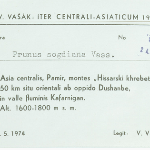 Subhashree Mishra Jan 9, 2015 01:37 |
This is a great research proposal to gain more understanding of the impacts of climate change in the Pamir region. It would be good to collaborate with the other proposers to help the people in the Pamir region better adapt to climate change by using data and results from this research effort.
|
 Libby Ellwood Jan 9, 2015 01:26 | Proposal contributor
@shree Thanks for your comment! I'm happy to collaborate with other proposers and welcome feedback, comments, or ideas to enhance the proposal.
|
 Venkatesh R Jan 9, 2015 09:28 |
Hi ellwood, This is a great idea,just a suggestion, if we can have some sessions in the schools and colleges around this area it will be great, and probably we can ask students to come up with some projects by giving the online resource, reverse knowledge gives us more information, as different team works on it, we can use this data to teach the community and moreover we are raising the knowledge and awareness, in the future generation. But not sure how much this is feasible in Pamir regions probably Shree can tell her views.
|
 Morgan Ruelle Jan 10, 2015 09:02 |
Hi ellwood! Thanks for your submission! I agree with Shree and vramanu that this is a great idea! As you know, there have been many herbarium-based studies of changes in plant phenology, but the results are rarely communicated to farmers and others who can use this information for climate adaptation. Can you be more specific as to how we would use the data from biodiversity collections to update the calendars? I scanned through your publication record and it looks like you would have some great ideas as to a methodology. I think an important first step would be to find correlations between plant phenologies and weather, and we will need the kind of historical data you are discussing to do so, but we will also need a source of historical weather data.
I have worked with Lakota elders who use plant phenophases as seasonal cues (e.g. the roses bloom when the frost is out of the ground). In those cases, the cue is usually used to take an immediate action, because it refers to a simultaneous event. The neat thing about the calendars of the human body is that they detect temporal relationships that are separated in time. For example, you might find out that the rose blooms are reliably correlated with something that occurs three weeks later, by counting 7 body parts forward (three days each).
I think vramanu is suggesting community participation in data collection, and I think that is a great idea. The USA National Phenology Network is a great example of citizen science related to plant and animal seasonality. I think this would really complement the work you have already proposed, because it would generate data, raise awareness, and inspire local application.
It would also be great to train/support Pamiri scientists as they digitize their biodiversity collections. An important local partner might be the Pamir Biological Institute: http://pbi.narod.ru/index.html
Thanks again and I really look forward to seeing this proposal grow!
|
 Karim-aly Kassam Jan 10, 2015 03:50 |
Dear Dr. Ellwood (Libby if I may),
This is a wonderful suggestion, indeed! Biodiversity collections are a powerful resource and you clearly have insight into how useful they can be. In terms of practical implications of your suggestion and its application, we need to first identify an area for which we have the largest and sustained data set(s). Then we need to identify a region in the Pamir where we have the calendar that can be the foundation for utilizing this (these) data set(s). With the calendar we have a starting point and with the data set we have elements of continuity. You have identified a key element in the process; now look at the process as a whole. How can each step of the process starting with: (1) an extant calendar, (2) combined with biodiversity data set(s), (3) additional ethnographic and phenological research lead to a proposal that revitalizes these ecological calendars to provide anticipatory capacity. Please look at this work, it may provide background that may lead to further insights (http://booksandjournals.brillonline.com/content/journals/10.1163/187471611x600369).
What I am saying is that you have hit on a key element but now work it through, what you are proposing is very exciting!
|
 Libby Ellwood Jan 12, 2015 03:05 | Proposal contributor
Thanks for all the helpful comments!
@vramanu - Bringing this idea into schools and colleges could be very powerful indeed. Because the data are freely available, it really comes down to ideas about what data to look for and what to do with it. With minimal training, just about anyone can participate and of course local knowledge is essential.
@morganr - You're right, weather data is the other important factor to this. Local weather would be ideal, but access to even regional weather data can be very helpful. Generally a warm year in the valley, or in the nearest city, is also a warm year in the nearby mountains. I will try to find a source for relevant weather data to add to the proposal. Your work with Lakota elders sounds very interesting. And, yes, a program like the National Phenology Network would be great for the Pamir region. I can envision a simplified version for the plant phenophases that are specific to the region. I worked on a project like this for the New England, where we developed a very simple, easy-to-use website for people to record their phenology observations, http://www.nelop.net/ . A site like this can easily be made that incorporates phenology observations, the body calendar, and even data from specimens.
It would be great to partner with Pamir Biological Institute and see what specimens are in their collections. Do you know if they have digitized any of their collections yet? I may be able to point them to resources if this is still a work in progress.
@kassam - Thanks for the suggestions - I agree that identifying an area for which we have the largest dataset would be helpful. I read the fascinating article you linked, and would like to know some of the specifics behind it. For example, is it possible to find out which species of crops are grown, which animals (migratory birds, birds of prey, worms, etc) were observed, or any other information that is part of the body calendar that I might be able to corroborate with specimen data? This type of information will go far in formulating a more comprehensive proposal.
Thanks!
Libby.
|
 Morgan Ruelle Jan 16, 2015 09:19 |
Hi Libby,
I don't know if the Pamir Biological Institute has digitized any of their collections, so I will write to ask a colleague who works there and ask if they have begun such a process. The Botanical Institute of the Tajikistan Academy of Sciences (in Dushanbe) looks to be another important collection to consider.
As for regional weather data, check out the FEWS-NET Central Asia Data Portal (http://earlywarning.usgs.gov/fews/sca/index.php). It looks like they have NDVI layers available for download, but not estimated rainfall (they do for East Africa, so I wonder if you contact them if you might be able to gain more info).
Thanks for sending the link to your site - I'm a Vermonter and my mom is a 3rd grade teacher so this would be a great activity for her students.
Best,
Morgan
|
 Morgan Ruelle Jan 21, 2015 12:24 |
Hi again Libby,
Just to follow up on my last comment, I wrote to a friend at the Pamir Biological Institute and she said that to her knowledge, none of the herbarium specimens in their holdings have been scanned.
Best,
Morgan
|
 Libby Ellwood Jan 27, 2015 12:29 | Proposal contributor
Hi Morgan,
Thanks for following up! Those weather data will be very helpful.
Imaging herbarium specimens and making them available online can be done even on a very tight budget and those data would be great to have for this research. Maybe I'll add that element to my proposal!
Thanks!
Libby.
|
 Morgan Ruelle Mar 4, 2015 05:43 |
Hi Libby,
I wanted to let you know that Climate CoLab as expanded the 'Summary' field to 4000 characters so that you can incorporate some of these new ideas into your proposal. I hope that helps!
Best,
Morgan
|
 Gabriel Harp Mar 31, 2015 05:36 |
Would there be a way to encapsulate, in 5-7 relatively simple steps, how this could activate local participation? I'm wondering in there are simple categories of skills, tasks, or activities that might make this an accessible and aspirational goal for a local community or regional climate service.
|
 Natasha Udu-gama Apr 17, 2015 09:54 |
Hi Libby,
29 days until this contest ends! At this point, I would encourage you to start fine-tuning your proposal. We now have an amazing set of judges from the National Consortium for Atmospheric Research (Dr. Greg Holland), The University of Maryland (Dr. Surya Sharma), College of the Atlantic (Dr. Doreen Stabinsky) and The Lowlander Center (Dr. Kristina Peterson) not to mention, our two esteemed advisors. Please see: https://www.climatecolab.org/web/guest/plans/-/plans/contestId/1301102.
I hope your proposal will wow them!
Best of luck!
Natasha
|
 Morgan Ruelle Apr 26, 2015 11:22 |
20 days left to iron out your proposal! Don’t forget to share with your networks to ensure as much useful discussion occurs before the deadline! Click on "Share conversation" at the top of this page!
|
 Libby Ellwood Apr 26, 2015 12:56 | Proposal contributor
Thanks @gharp for your helpful comment. I have made major edits to the proposal and included steps to activate local participation, particularly under "Who will take these actions".
|
 Morgan Ruelle May 1, 2015 09:03 |
15 days left to ensure all content on your proposal is as detailed and accurate as possible! Share your proposal on Facebook, Twitter, LinkedIn or send an email to colleagues asking for comments on your ideas!
|
 Morgan Ruelle May 13, 2015 06:08 |
3 days left until the judges will read through your proposal! Take this chance to invite others to weigh-in and ensure your proposal is as comprehensive and accurate as possible! Now is the time to make any last minute changes!
|
 Libby Ellwood Jun 9, 2015 06:00 | Proposal contributor
Thank you to the Judges for the helpful feedback. I have addressed your concerns in this version of the proposal and feel it is improved as a result. I will be continuing to improve upon the proposal until the deadline.
I encourage feedback from anyone interested in reading the proposal and will integrate additional comments and edits as I can.
|
 Natasha Udu-gama Jul 28, 2015 04:01 |
Hi Libby,
Just to let you know, proposals are blocked for any edits until the end of the voting period (August 3 - September 12).
Apologies for the delay in my reply, I've been out of the country for some time.
Thanks,
Natasha
|
